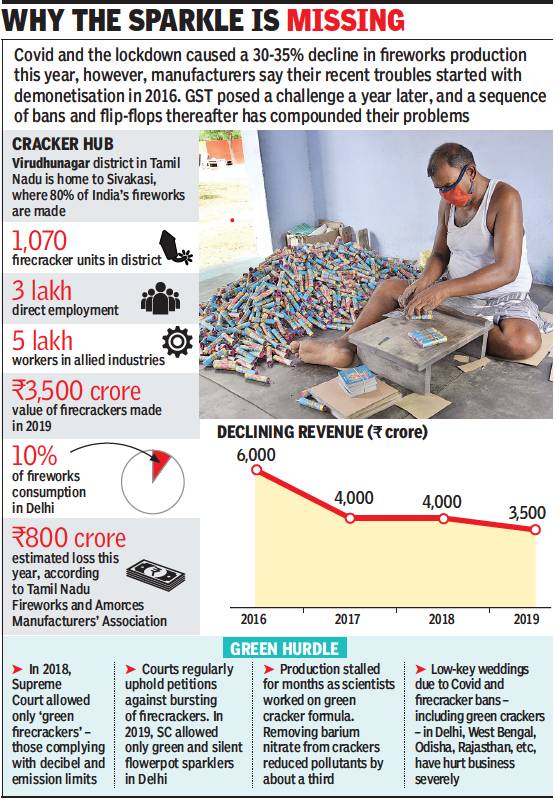Sivakasi, Virudhunagar
This is a collection of articles archived for the excellence of their content. |
Contents |
The firecracker industry
2016-19, 2020
Ananth MK, November 14, 2020: The Times of India

From: Ananth MK, November 14, 2020: The Times of India
Will Sivakasi’s firecracker units survive the coronavirus?
The future looks grim for the 1,070 units of the nearly century-old fireworks industry that employs lakhs of workers in and around Sivakasi — the pyrotechnics capital of India. Hit by the pollution row over the past four years, and Covid-19, sales have plummeted.
“By this time, the factories would be completely cleaned out with all their stocks dispatched. But due to the ban by various states and other uncertainties, some are left with up to 20% of their annual stock,” said A S Rajendra Raja, vice president of Indian Fireworks Manufacturers’ Association.
The association says it targeted only 70% of its usual production this year, yet fears an overall loss of at least 45%. A complete ban on crackers in Rajasthan (12% of sales), Delhi (10%), West Bengal (10%) and Odisha (3%), and permission to light only green crackers in Karnataka, have hurt the business. Some wholesalers have asked manufacturers to cancel orders that have been dispatched while others want refunds for unsold stock.
“The loss cannot be recovered,” Raja said, adding that if the crisis persists they will be forced to switch to other industries. P Ganesan, president of the Tamil Nadu Fireworks and Amorces Manufacturers’ Association and a major manufacturer, said they will again try to convince the Centre and the apex court to permit fireworks for Diwali. “We will then decide on sustaining or leaving the industry.”
To survive, the industry is trying to establish a CSIRNational Environmental Engineering Research Institute laboratory in Sivakasi for making more types of green fireworks. The manufacturers also hope the government will recognise green fireworks to quell doubts among buyers and activists. As green fireworks are still a new thing, there is a lot of scepticism about them even in the industry.
Fireworks production in the region has steadily declined over the years, from an estimated value of Rs 6,000 crore in 2016 to about Rs 3,500 crore in 2019. Some industrialists switched trades when stringent workplace safety norms were implemented, as the changes required were expensive. Some others diversified when Chinese fireworks dented demand for those made in India.
“Some established educational institutions and a handful started showrooms and furniture outlets while continuing in the traditional fireworks business,” said Sivarajah Ramanathan, founder and CEO of Nativelead, an organisation promoting new-age entrepreneurship in non-metro regions.
Sivakasi town secretary of CPM, K Murugan, said workers of firecracker units are suffering as demand has fallen. “Workers are at the receiving end and are clueless about the future of their jobs.” He said lakhs of people cannot be provided alternative jobs at once and the government needs to step in.
2022
K Kaushik, Oct 26, 2022: The Times of India
Virudhunagar : Despite a dip in production, the fireworks industry in Virudhunagar district of Tamil Nadu has seen a business between Rs 4,000 crore and Rs 5,000 crore due to good sale of crackers this Diwali.
A hub for fireworks manufacturers, Virudhunagar contributes to nearly 90% of the country’s production. There are over 1,000 fireworks units in the district and nearly eight lakh employees are directly and indirectly dependent on this industry for their livelihood. Murali Asaithambi, vicepresident of Sivakasi Fireworks Manufacturers’ Association, said the industry usually records a business of Rs 7,000-Rs 8,000 crore everyyear. However, for the past few years, there has been a decline in business due to various restrictions.
“There was good demand in the market this Diwali. We estimate the business to be between Rs 4,000 crore and Rs 5,000 crore. The final figures will be known in a week. Business has been almost the same since 2018 following the Supreme Court’s ban on use of barium nitrate and manufacture of joint crackers. Barium nitrate was used in 40% of firework varieties. Joint crackers contributed to another 40% of the total production. With the ban, the industry is able to manufacture only 20% varieties of fireworks. This has resulted in a decline inproduction by 40%. The sale will be commensurate with production,” he said.
On the future of the industry, Asaithambi said the ban should be revoked for the industry to become stable once again and achieve 100% production. Indian Fireworks Manufacturers Association general secretary T Kannan said production has come down to nearly 60% this year. However, due to good demand in the market, the sale was good despite a 25% price hike. “Owing to good demand, all stocks from the district have been cleared. This could be seen as a positive sign and we might be able to increase production for next year,” Kannan said.